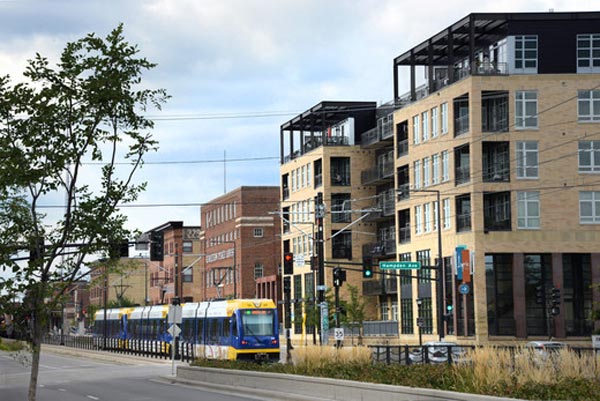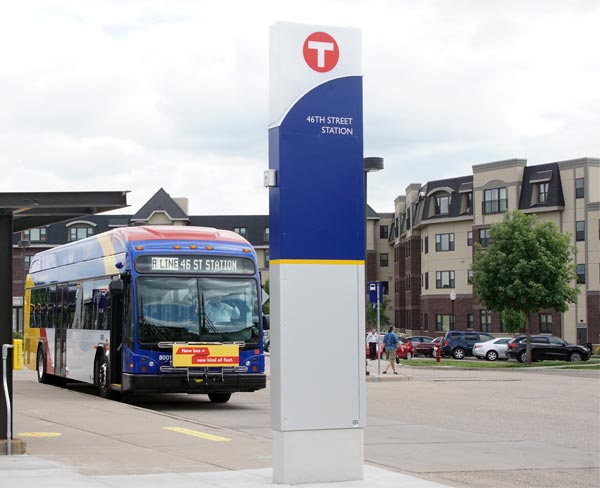Development Trends Along Transit - 2024
The success of a region depends in part on the quality of its connections. Together, robust high frequency transit and Transit Oriented Development efficiently tie housing, jobs, shopping, and more. Recognizing this, the TOD office studied the patterns of permitted and planned developments in the Twin Cities, with a focus on those developments along high frequency transit.
In the 14 years between 2009 and 2023, permits have been issued for over $49.9 billion throughout the region. This includes projects that have been completed since being permitted, and ongoing projects. Developments located near high frequency transit have been permitted for just over $19 billion. Of that $19 billion, $12.8 billion is located within one half mile of a light rail transit (LRT) station, $9 billion is located within a half mile of a bus rapid transit (BRT) station, and $3.3 billion is served by high frequency local bus routes outside areas with direct LRT or BRT service. All told, the permitted value of development within transit corridors represents 38.4% of the development that has been permitted for the region, on just 3.4% of the region’s land area.
This report reveals that $19 billion in development has been permitted along high frequency transit between 2009 and 2022, including:
- 44% of the region’s multifamily development by permit value
- 44% of the region’s commercial development
- 31% of the region’s public and institutional development
- 5% of the region’s industrial development
The Council also tracks regional development news, identifying potential future developments through media coverage and other sources. Based on this tracking, 68% of the planned developments are anticipated to be near high frequency transit.
View the full report here.
Property Value Tax Analysis
In 2023, the TOD office also began an analysis of property tax values near high frequency transitways in the region. This analysis was shared with the Metropolitan Council (view meeting video here) and will be shared through a web application, currently under development.
The property tax value analysis found that parcels near high frequency transit account for just 2% of the taxable parcels in the region but generate over 25% of the region’s property tax revenue. Tax revenue from properties within ¼ mile of transit increased much faster than properties further from transit and this increase is heavily driven be new infill development.
The following exhibits show 3D mapping of property tax values over time near different transit lines. Simply scroll through the documents to see property tax value over time.
- Property Tax per Acre 2006-2023
About the TOD Office
Metro Transit TOD is a one-stop shop for developers and urban planning professionals interested in pursuing or advancing Transit Oriented Development (TOD) in the Twin Cities.
The Metro Transit TOD Office is a branch of the Metropolitan Council and was founded in coordination with the region’s TOD Policy. As part of this policy, the TOD Office works to advance the following goals in all of our work:
1. Maximize the development impact of transit investments by integrating transportation, jobs and housing.
2. Support regional economic competitiveness by leveraging private investment.
3. Advance equity by improving multimodal access to opportunity for all.
4. Support a 21st century transportation system through increased ridership and revenues.
Questions? Please contact the TOD Office.
How can the TOD Office help you?
The TOD Office offers expertise, resources and connections to the Twin Cities and national TOD network.
We strive to be a resource for any TOD-related question or project, large or small, and will connect you to the right property owner, funding opportunities or organization to get you what you need. Additionally, the TOD Office is also equipped to help with:
Resources for TOD planning professionals
If you are a local planner seeking assistance with integrating TOD into your comprehensive plan; understanding the roles of the various levels of government involved in planning and implementing TOD; or in search of local case studies, initiatives and lessons learned; take a look at the Metropolitan Council TOD Guide and related resources.
Welcome to Metro Transit TOD! Click below to learn how WE can help YOU.
What is TOD?
TOD is walkable urban development supported by high quality, frequent transit service. TOD includes a mix of housing, retail, employment, retail and recreational choices, allowing people to live and work in vibrant places with less dependence on a personal car.
TOD plays a vital role in maximizing the impact of transit investments, increasing regional competitiveness and advancing equity and health.


Contact us
[email protected]
Michael Krantz, PE,
LEED-AP ND
Senior Manager
Clayton Watercott
Planner - GIS
Amy Yoder
Planner
Margaret Perez
Senior Project Manager
Jason Schmidt
Senior Project Manager